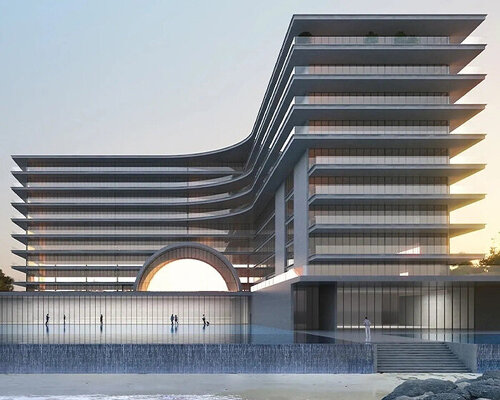the wave of fashion houses building real estate empires grows
Maison Margiela unveils Maison Margiela Residences, marking the House’s first venture into residential living. The project translates its codes of deconstruction, trompe-l’oeil, and transformation into a luxury living environment in one of Dubai’s most exclusive settings. The announcement situates Margiela among a growing constellation of fashion houses redefining luxury through architecture. From Armani and Bulgari to Versace, Fendi, and Dolce & Gabbana, high-fashion labels are increasingly translating their aesthetics into brick and mortar, creating hotels, condos, and branded residences that allow clients to live inside the signature world of each brand. On the occasion of Margiela’s debut, designboom takes a closer look at why and how fashion brands are expanding into real estate and what it reveals about the evolving relationship between design, lifestyle, and architecture.
from couture runways to luxury residences
High-fashion houses are no longer confined to boutiques and runways, moving over to creating spaces to experience the brand in a more intimate way. Over the past three decades, labels from Armani to Versace have extended their aesthetic worlds into architecture and real estate. The phenomenon began around the turn of the millennium, when visionary designers recognized real estate as the ultimate medium for immersive brand storytelling.
Gianni Versace and Diesel founder Renzo Rosso were among the earliest pioneers. Versace’s Palazzo Versace on Australia’s Gold Coast (opened 2000) brought the Baroque glamour of the house to five-star hospitality, while Rosso transformed Miami Beach’s Pelican Hotel into an eccentric fashion playground as early as 1990.
Armani Beach Residences, a collaboration with architect Tadao Ando in Dubai
a lifestyle beyond flagship stores
For today’s fashion houses, real estate represents a design opportunity and a business evolution. Hotels and residences offer a way to materialize the lifestyle philosophy of the brand in three dimensions, inviting clients to inhabit the label’s universe in a different way from what a flagship store does. The late Giorgio Armani described it as ‘exploring my idea of living,’ a natural continuation of Armani/Casa’s design character.
Through licensing partnerships and co-developments, fashion houses gain revenue streams and long-term brand visibility. In markets like Dubai, Miami, and Marbella, branded residences often command price premiums. The Residences by Armani/Casa tower in Sunny Isles Beach, designed with César Pelli, sold out 308 units, buoyed by the allure of the Armani name and interiors tailored to the brand’s signature design. As Renzo Rosso, founder of OTB Group, Maison Margiela’s parent company, puts it, these projects ‘define the unmistakable style of each fashion house’ while transforming creative vision into built form.
Fendi Private Suites in Rome
transcribing fashion codes into architecture
Each fashion-led development mirrors the house’s aesthetic language. At Palazzo Versace Macau, the latest addition to Versace’s hospitality portfolio, every mosaic, carpet, and tile channels the House’s Italianate opulence, Medusa motifs swirl across terrazzo floors, and the mosaic pattern from Versace’s Milan palazzo reappears in the lobby.
Bulgari’s hotels, by contrast, exude refined craftsmanship. Designed by Milan’s Antonio Citterio Patricia Viel (ACPV), each property, from Milan to Paris and Shanghai, features hand-finished marble surfaces, silk, and bronze detailing.
The Armani Hotel Dubai and Armani Residences within Burj Khalifa flow in earthy tones and low-lit calm, every material chosen to create a harmonious atmosphere and add texture. As the brand expands with Armani Beach Residences, a collaboration with architect Tadao Ando, the minimalist vision reaches new architectural heights.
Missoni’s approach, meanwhile, is unapologetically chromatic. The Missoni Baia tower in Miami, Missoni Sky in Toronto, and the Missoni Resort Club in Mykonos translate the brand’s zigzag knits into structural geometry, while vibrant interiors evoke the optimism and color that define its fashion.
Missoni Baia tower in Miami
from karl lagerfeld’s dreams to dolce & gabbana’s palazzi
Some designers have taken the leap even further. The late Karl Lagerfeld’s hotel in Macau, opened posthumously in 2021, is an East-meets-West fantasy of chinoiserie and Art Deco, complete with a 360-square-meter library and a literal fountain centerpiece. Every object, from the key-patterned walls to the antique volumes, bears his personal touch. By the mid-2010s, Fendi had also unveiled a boutique hotel, Fendi Private Suites, a set of seven plush suites above its Rome flagship in 2016, and partnered on the beachfront Fendi Château Residences condo in Miami.
Dolce & Gabbana’s recent ventures represent the next evolution. The duo is developing the 888 Brickell tower in Miami, a 90-story condo-hotel featuring Murano glass chandeliers combined with animal-print velvet, and Marbella Design Hills in Spain, a 92-unit complex furnished entirely with Dolce&Gabbana Casa pieces.
Even Diesel, rooted in denim and counterculture, has entered the space with Diesel Wynwood Condominium in Miami, the first Diesel-branded residential project. Designed with Zyscovich Architects, it channels the brand’s industrial energy through raw concrete, street art, and Diesel Living furnishings, targeting a younger generation of design-savvy buyers.
888 Brickell Miami Residences And Hotel by Dolce & Gabbana
Diesel Wynwood in Miami
Design Hills Marbella by Dolce&Gabbana
Maison Margiela Residences in Dubai
The post why and how fashion’s biggest names expand into architecture and real estate appeared first on designboom | architecture & design magazine.

